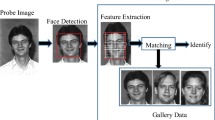Abstract
Human faces have two important characteristics: (1) They are similar objects and the specific, variations of each face are similar to each other; (2) They are nearly bilateral symmetric. Exploiting the two important properties, we build a unified model in identity subspace (UMIS) as a novel technique for face recognition from only one example image per person. An identity subspace spanned by bilateral symmetric bases, which compactly encodes identity information. is presented. The unified model, trained on an obtained training set with multiple samples per class from a known people groupA, can be generalized well to facial images of unknown individuals, and can be used to recognize facial images from an unknown people groupB with only one sample per subject. Extensive experimental results on two public databases (the Yale database and the Bern database) and our own database (the ICT-JDL database) demonstrate that the UMIS approach is significantly effective and robust for face recognition.
Similar content being viewed by others
References
Turk M, Pentland A. Eigenfaces for recognition.Journal of Cognitive Neuroscience, 1991, 3(1): 71–86.
Edwards G, Taylor C J, Cootes T. Learning to identify and track faces in image sequences. InProc. Sixth IEEE Int. Conf. Computer Vision, Bombay, India, 1998, pp. 317–322.
Costen N, Cootes T, Edwards G, Taylor C J. Automatic extraction of the face identity-subspace.Image and Vision Computing, 2002, 20: 319–329.
http://cvc.yale.edu/projects/yalefaces/yalefaces.html.
ftp://iamftp.unibe.ch/pub/Images/FaceImages/
Belhumeur P N, Hespanha J P, Kriegman D J. Eigenfaces vs. Fisherfaces: Recognition using class specific linear projection.IEEE Trans. Pattern Analysis and Machine Intelligence, 1997, 19(7): 711–720.
Swets D L, Weng J. Using discriminant eigenfeatures for image retrieval.IEEE Trans. Pattern Analysis and Machine Intelligence, 1996, 18(8): 831–836.
Etemad K, Chellappa R. Discriminant analysis for recognition of human face images.Journal of the Optiical Society of America A, 1997, 14: 1723–1733.
Moghaddam Baback, Jebara Tony, Pentland Alex. Bayesian face recognition.Pattern Recognition, 2000, 33(11): 1771–1782.
Liu Chengjun, Wechsler Harry. Probabilistic reasoning models for face recognition.IEEE Computer Society Conference on Computer Vision and Pattern Recognition, Santa Barbara, CA, USA, 1998, pp. 827–832.
Duvdevani-Bar Set al. A similarity-based method for the generalization of face recognition over pose and expression. InProc. 3rd IEEE Int. Conf. Automatic Face and Gesture Recognition (FG'1998), Nara, Japan, 1998, pp. 118–123.
Kirby M, Sirovich L. Application of the Karhunen-Loeve procedure for the characterization of human faces.IEEE Trans. Pattern Analysis and Machine Intelligence, 1990, 12(1): 103–108.
Penev P S, Sirovich L. The global dimensionality of face space. InProc. 4th IEEE Int. Conf. Automatic Face and Gesture Recognition (FG'2000), Grenoble, France, 2000, pp. 264–270.
Author information
Authors and Affiliations
Corresponding author
Additional information
This work is supported partly by Youth Fund of Institute of Computing Technology (Grant No.20026180-17) and the National Natural Science Foundation of China (Grant No.60303018).
Pin Liao received the B.S. degree in computer science from Nanchang University, China in 1996, the M.S. degree in pattern recognition and intelligent system from Beijing Institute of Technology in 1999, and the Ph.D. degree in computer science from Institute of Computing Technology (ICT), the Chinese Academy of Sciences (CAS) in 2003. His current research interests include pattern recognition, machine learning, computer vision, and neural networks.
Li Shen was born 1937. He graduated from the Department of Electrical Engineering, Zhejiang University, Hangzhou, China, in 1959. Since then, he joined the Institute of Computing Technology, the Chinese Academy of Sciences, Beijing, where he is currently a professor. He is an IEEE senior member. His research interests include soft computing, ASIC design, design for testability and fault testing.
Yi-Qiang Chen received the B.S. and M.S. degrees in computer science from Xiangtan University, in 1996 and 1999, respectively, and the Ph.D. degree in computer science from ICT, CAS in 2003. He is currently an associate researcher of Institute of Computing Technology. His research interests include machine learning, multimodal interface and bioinformatics.
Shu-Chang Liu received the B.S. degree in computer science and the M.E. degree in management science and engineering from Shandong Normal University, in 1996 and 1999 respectively, and the Ph.D. degree in computer science from ICT, CAS. His current research interests includeaudio/speech signal processing, computer music, multimedia data hiding, mobile digital rights management, etc.
Rights and permissions
About this article
Cite this article
Liao, P., Shen, L., Chen, YQ. et al. Unified model in identity subspace for face recognition. J. Comput. Sci. & Technol. 19, 684–690 (2004). https://doi.org/10.1007/BF02945595
Received:
Revised:
Issue Date:
DOI: https://doi.org/10.1007/BF02945595




